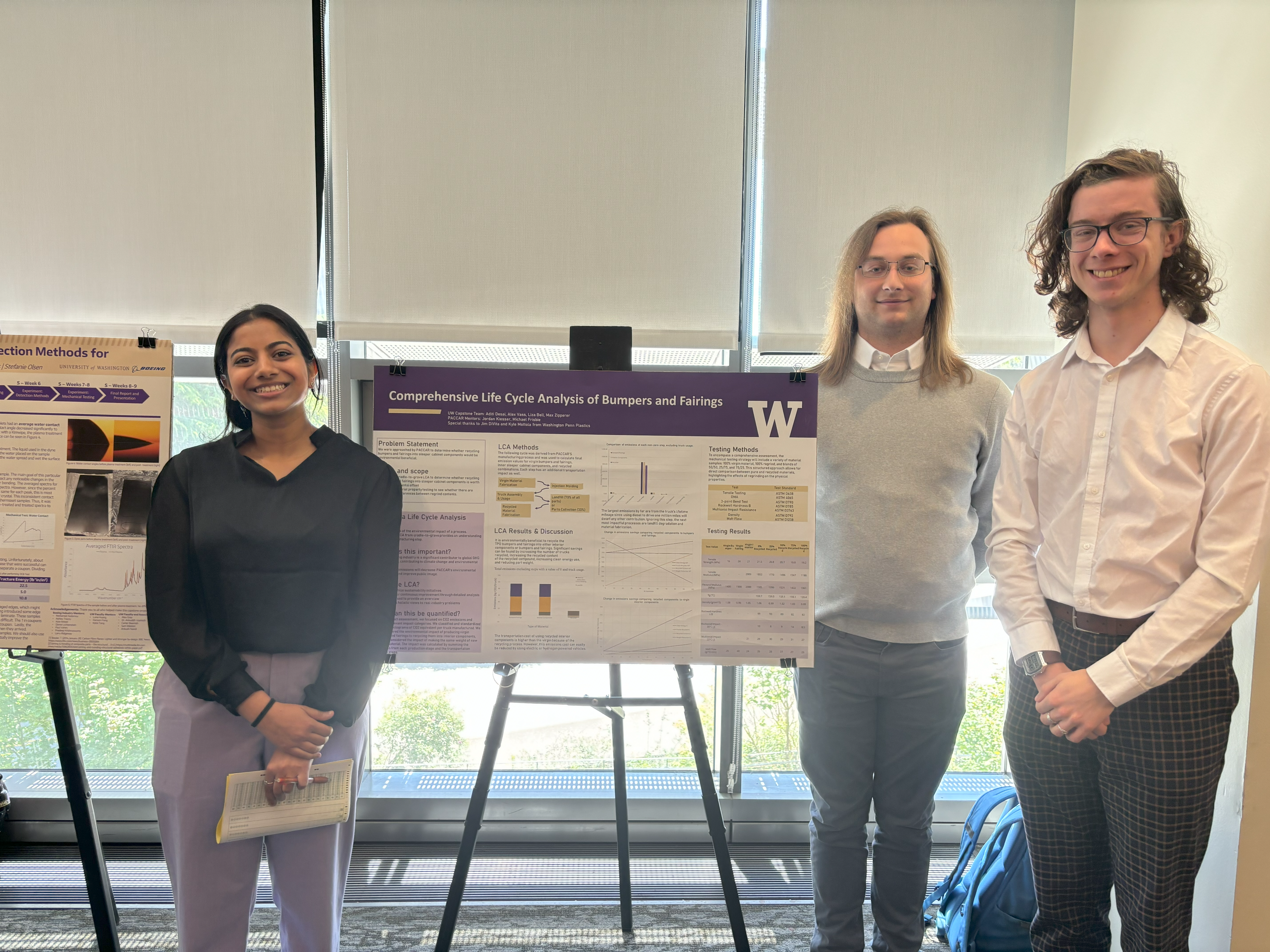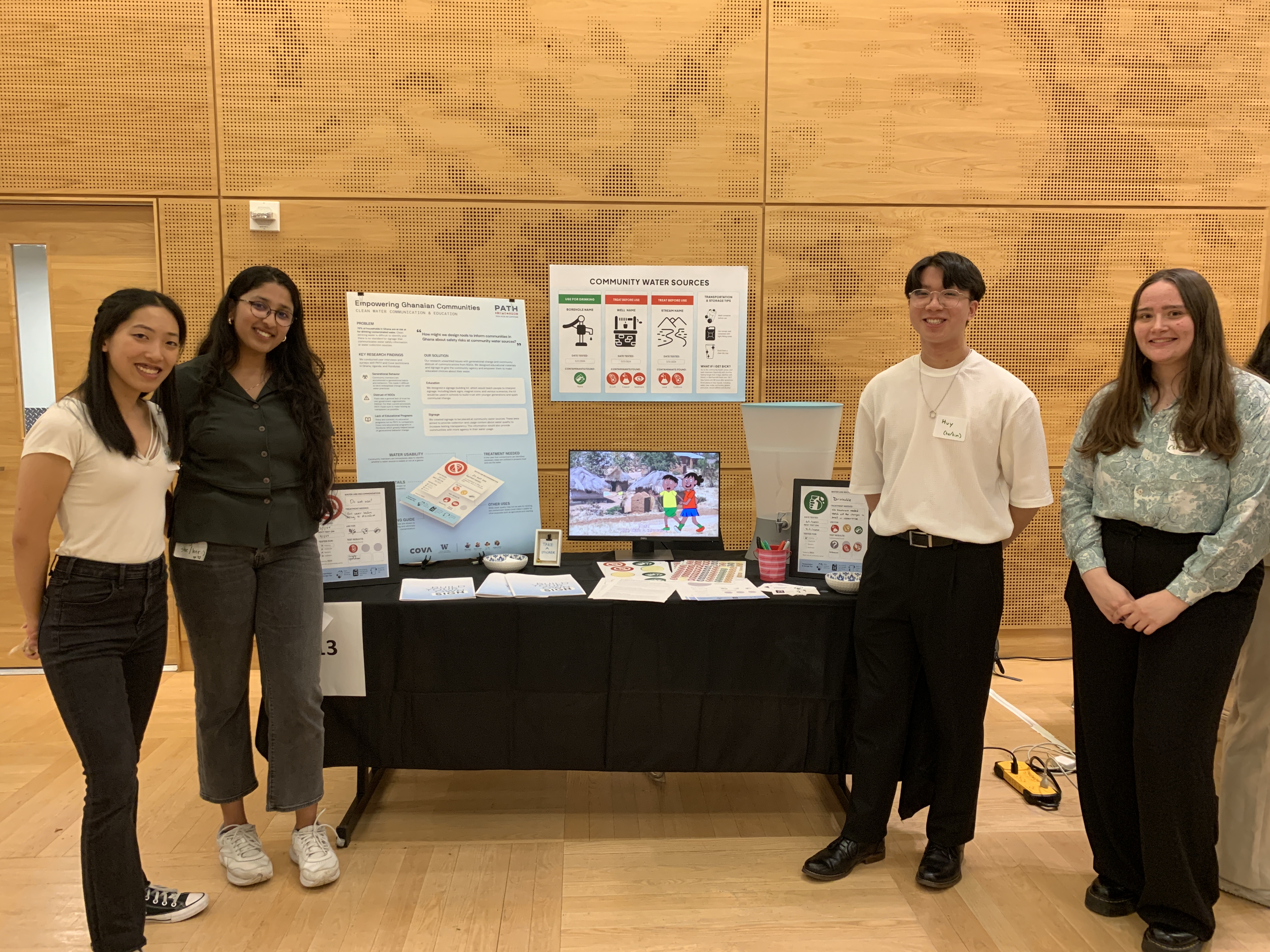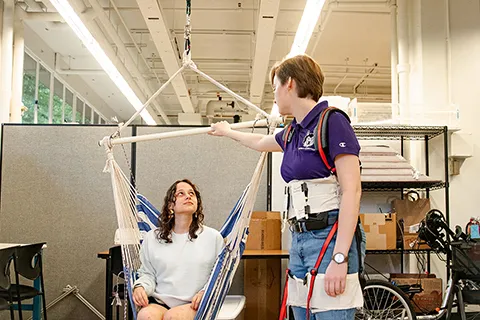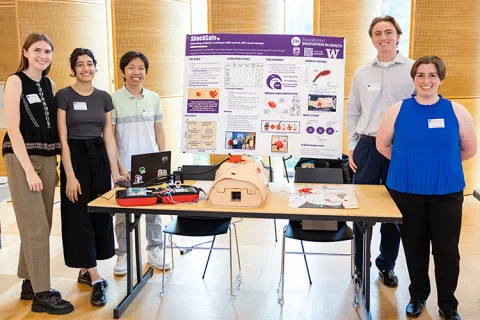Industry-Sponsored Student Capstone Projects
2023/2024
In the 2023/24 academic year, the industry capstone program was supported by 54 sponsors, more than half of which were returning, and 95 real-world projects. Over 550 students from across the College of Engineering participated. Scroll down to learn more about each project.Novo Nordisk
Sickle Cell Disease Provider Chatbot
There is approximately 100k people in the US living with sickle cell disease (SCD). As a rare disease, SCD is often not treated effectively in the care setting with many providers not identifying the symptoms of the condition or understanding how to treat effectively. This situation is oftentimes complicated by compounding factors such as racial bias, medical staff unawareness, financial hardship, cultural distinctions, and lack of disease state expertise. To help reduce these detrimental factor at the provider level, this student team will work to design and develop a tool which would supply the physician with an easily accessible set of clinical and behavioral protocols to identify and best treat the SCD patient. This student team will work to create chatbot container utilizing chat features such as iMessage and Messenger. The core and primary function of this tool would be to work from the unique set of provider inputs to algorithmically train from these inputs to help lead/teach the physician a manner of care aligned to the physician’s personal care style, as well as the care (clinical and behavioral/emotional) of a particular SCD patient. Some of the key objectives this student team will work to evaluate when designing the SCD chatbot include: • Data models focused on SCD treatment and disease state – protocol data for clinical analysis and treatment • Demographic data as per SCD population • Analysis of emotional/behavioral/cultural attributes to determine the care data associated with treating SCD • The tool would ideally be capable of assessing the “care style” of the provider and align that to the patient need set. • Adopting the mobile moments (ease of access) from the message toolset, the chatbot could operate outside the application container and function in a conversational manner as a “friend” to the physician. The objectives this student team will work to achieve are: • A working prototype, end-user platform via iMessage and/or other messaging application • A solution accessible from smartphone • A name and branding for tool • An optimized user-centric (physician) designs and workflow (UX)

PACCAR
Autonomous Driver Vehicle Test Interface
PACCAR has a need to evaluate vehicle response from autonomous driver inputs, regardless of the autonomous driver system in use. PACCAR Technical Center (PTC) strives to develop a mechanical and electrical interface that would allow a human driver to act as the autonomous driver through a set of redundant controls inside the truck cabin. This student team will work to specify the human driver interface system components and design the mechanical interface to the truck cabin. Components required include an electronic steering wheel, throttle pedal, brake pedal, driver display and interface(Speedometer, turn signals, lights, wipers, etc.) and provisions for an electronic control unit mounting. The interface this student team will work to create should: - allow verification of controls response to lateral, longitudinal commands, and driver inputs (lights, turn signals, cleaning, etc.) - be capable of being installed in various PACCAR vehicles (Kenworth, Peterbilt) - be capable of being utilized by individuals of varying height, weight, gender, etc. - have durable and reliable components capable of withstanding Class 6-8 vehicle duty cycles - have a realistic, comfortable, and intuitive driver feel (e.g. not computer game) General Schedule: Background and ideation - 4 weeks, Concept development - 4 weeks, Prototype development - 4 weeks, Prototype testing 8 to 12 weeks The outcome this student team will work to achieve includes: A physical prototype of the human driver interface system components and mechanical vehicle interface. Future year extension: Design the electrical/controls interface between the human driver control components and the autonomous vehicle platform.

PACCAR
BEV Range Estimation Tool - Part 3
Battery Electric Vehicles (BEVs) are a hot topic in the world of automotive engineering. "Energy" is not as disposable as it was with internal combustion engine vehicles. Drivers are very calculated and methodical while preparing routes so as not to run out of battery energy while driving to avoid having to wait while charging. The BEV range estimator tool this student team will work to create will take away this range anxiety from the drivers and give them an accurate value for the miles they can travel. This student team will work to complete all of the following tasks: Task 1: Develop a MATLAB Simulink based powertrain model for a BEV using performance information. Task 2: Use time-series vehicle data to predict the energy consumption of a vehicle. Task 3: Compare the energy consumption estimation and prediction from Task 1 and Task 2. Task 4: Create a user interface that allows inputting a drive cycle and initial SOC and output a graphical representation of the estimate range of the vehicle. Task 5: Link the front end UI to the back end model developed in Task 1 or Task 2 for computation. Task 6: Validate the end model developed on an engineering truck or in a simulated environment. (Note that these tasks do not need to be started or completed in the order mentioned above.) The outcomes this student team will work to determine include: - Prediction of energy consumption of a vehicle - A range estimation tool - An analysis report detailing the findings of the energy consumption of a vehicle and a range estimation tool

PACCAR
E-Truck Control Architecture
The electrification of trucks introduces many interesting new vehicle control challenges. For instance, the incorporation of an electric drive-train requires the development of a control architecture that incorporates the electrical system with the rest of the truck. In this project the student team will work to design a preliminary control architecture with the help of industry-standard tools and computer simulation. As a necessary first step in this design process, the student team will work to study and understand the control architecture of the original diesel truck. The student team will work to model the control architecture to provide a software/hardware-in-the-loop optimization capability. Completion of the initial architecture definition and documentation is required. This student team will work to provide: 1) a schematic of the control architecture of the original truck, 2) a schematic of the modified truck with all relevant parameters, 3) supporting documentation: component selection, design assumptions, simulation results, design requirements/specifications, safety, and discussion and limitations of the chosen design.

PACCAR
E-Truck Electrical Architecture
The electrification of trucks introduces many interesting architectural questions. For instance, the peak and operating voltage will need to consider available drive-line, battery and power electronics components. Meanwhile, this student team will work to consider the efficiency implications and conduct trade studies. In this project the student team will work to design a preliminary electrical architecture with the help of industry-standard tools and computer simulation. As a necessary first step in this design process, the student team will work to study and understand the electrical architecture of the original diesel truck. This student team will work to model Electrical Architecture to provide a software/hardware-in-the-loop optimization capability. This student team will work to complete the initial architecture definition and documentation (this is required). Outcomes this student team will work to achieve include: 1)A schematic of the electrical architecture of the original truck, 2) A schematic of the modified architecture for E-truck with all relevant parameters, 3) Supporting documentation: component selection, design assumptions, simulation results, design requirements/specifications, safety, and discussion and limitations of the chosen design.

PACCAR
E-Truck Retrofit Packaging Optimization
This student team will work to build an initial CAD model of an ICE vehicle (a diesel powered medium-duty commercial truck) and will explore optimization of packaging layout with the goal to retrofit and convert vehicle to a fully electric powered vehicle (EV). This student team will work to complete an initial mechanical design of the converted truck. The first step the student team will work toward is to develop SolidWorks drawings of the original truck. Once these drawings have been developed, the student team will work to redesign the truck to accommodate electric motors and drivetrain, batteries, high and low voltage cable/harnesses, and other mechanical changes required for a successful conversion to EV. The outcomes this student team is working to accomplish include: 1) SolidWorks Drawings of the original truck, 2) SolidWorks drawings of the modified truck, 3) supporting documentation: component selection, design assumptions, calculations, design requirements/specifications, and discussion and limitations of the final design.

PACCAR
E-Truck System Definition and Modeling
The E-Truck project is an interdisciplinary four-year student led project to convert a diesel powered medium-duty commercial truck to an Electric Vehicle (EV). To successfully complete this conversion, this student team will need to determine the performance parameters of the EV that the team is going to design. In other words, this student team will need to work to determine realistic and firm design goals. This student team will first work to learn about the performance characteristic of diesel powered medium-duty commercial trucks. This will be followed by a comprehensive study of what would be required from an electrically powered truck for it to be accepted by the marketplace. This student team will use this information to select the design requirements in terms of performance parameters for the converted truck. The student team will work to determine design goals such as maximum payload, range, typical use, weight, acceleration, brake performance, cost of vehicle, service life, cost of operation, safety, etc. In order to meet this goal, the team will need to work to: - understand vehicle sub-systems and overall logical architecture. - model functional and physical architecture of the new system. - explore relevant properties to define system performance and implications - develop initial requirements drafts to articulate system goals. The outcomes this student team is working to achieve include: 1) System Modeling Language (SysML) of Electric Truck architecture. 2) Requirements specifications for stakeholders and system.

PACCAR
H2 Selective Catalytic Reduction (SCR) System
This student team will work to investigate selective catalyst reduction technology that uses H2 as a reducing agent to selectively reduce NOx produced by H2 combustion to N2 and H2O. This student team will work to use available scientific literature on the topic to understand current status and trends for H2 SCR. This student team will work to conduct research aimed at developing knowledge and will work to produce a paper study that explores existing technology in the H2 SCR space. This student team will work to deliver on the following: - Investigate difference in substrate use, metal used for ion, wash coat. - Understand change in space velocity due to increased reaction rates. This student team will work to illustrate an understanding of the status of H2 SCR technology and current paths under investigation that show promise. This student team will work to achieve the following outcomes: Work to identify what is the current selectivity of H2 SCR. Work to define the current temperature range of H2 SCR. Work to identify the by products of H2 SCR with H2 combustion exhaust. Work to identify the washcoats in use with H2 SCR. Work to identify the metal(s) in use with H2 SCR. This student team will also work to explore how using H2 differs from using ammonia in terms of temperature.

PACCAR
LCA of Bumper and Fairings and Impact of Using Recycled Material
Virgin polyolefin materials are used for mold-in-color bumper and fairing structures. These materials are recyclable but there is not currently a closed loop recycling system setup for these parts. A life-cycle-assessment (LCA) has not been conducted to evaluate the impact of these parts on product sustainability. This student team will work to conduct a LCA to determine sustainability improvements of using regrind materials from bumpers and fairings at the end of their life as sleeper cabinet components. Conduct material property tests on recycled material to determine reduction in material properties. This student team will work to evaluate the Kenworth Aero Bumper and Fairings to develop the LCA. This student team will need to gather input data from a part supplier (ConMet and/or Creative Liquid Coatings) and material supplier (Washington Penn Plastics) to conduct the LCA. This student team will work to conduct a LCA that will include use of virgin materials for bumper and fairings and compare use of regrind material vs virgin material for sleeper cabinets. This student team will work to perform material property testing (Tensile, Flexural, impact) at UW to compare virgin to regrind materials to determine the reduction in material properties. Virgin and regrind material samples will be provided by the material supplier, Washington Penn Plastics. The outcome this student team is working to achieve is to determine sustainability improvements that can be gained by using regrind material from bumpers and fairings at the end of their life for other components such as sleeper cabinets.

PACCAR
PACCAR Technical Center PTO Load Simulation
This student team worked to plan, define, design, build, and test a new power takeoff load simulation device that allows for on road and mobile parasitic load testing of commercial vehicles (i.e., trucks with trailers) and is capable of applying a load of up to 95HP (71KW) 500lb-ft (678Nm) to a bottom or side mounted power take off (PTO) to better serve PACCAR Technical Center's customers. This student team took into account the following parameters: Safety, lifespan, cost, functionality, load capacity & dissipation, fluid/hydraulic system, control system, human machine interface (HMI)

PACCAR
Real-Time "Frame Twist" Measurement Device
This student team will work to design, construct, and validate a measurement device capable of recording truck/trailer frame twist with a simple test install and integration with current CAN based DAQ system. The device the student team is working to create will be installable on trucks or trailers and will measure frame torsional deflection to within ±0.1deg at >50 Hz. The student team will work to provide digital data output via CAN messages that should include angular data and health status/confidence, as well as self diagnosis and calibration functions. The outcome this student team is working to accomplish is a device validated to meet the performance requirements.

PACCAR
Virtual Brake Timing Test
This student team worked to create a methodology for virtually testing the application delay of different air brake system designs to augment current physical testing. This student team worked to test and model how the influence of individual brake components can effect a combined system, assemble those components into a full system, then physically test that system and work out system simulation based on the component models, and prove out the virtual test methodology.
Parkalytics
Automatic Georeferencing for UAV video
World coordinates for observations in UAV data are valuable for tracking real objects e.g., vehicles. However, robust automatic matching between image and world coordinates remains elusive. Changes in camera pose are common in video captured from UAVs, and can be challenging. This student team will work to build a process for automatically georeferencing video from UAVs, detect and match features for georeferencing, track and update features under pose changes, and output georeferenced video and transforms. The key milestones this student team will work to accomplish are: - a Literature review and data set gathering - A basic prototype that is functional - Field testing and integration -Iteration
Parkalytics
Next-Gen Biodiversity Monitoring with Drones and AI
There is a desperate need to efficiently monitor changes in biodiversity as we attempt to mitigate species loss associated with climate change and other human impacts. Drones can cover significantly larger areas than human teams, but data processing remains an issue. This student team will work to create a set of tools that will greatly increase survey speed and accuracy for assessing large areas for evidence of habitation e.g. bird nests. This student team will work to create, from scratch, a set of tools to enable drone based biodiversity monitoring. Through this project, this student team will work to: - Create a web app for inspecting a 3D scene in detail using crowd-sourcing and AI (stretch goal) - Build/Integrate image labeling tools - Build relationships between 2D images and 3D scene for de-duplication and enhanced inspection - Automate photogrammetry for building 3D scene from inputs - implement coverage guarantees for biodiversity measurement as well as potential search and rescue applications. A successful project would be the first step towards bringing a new and impactful product to market in a field that is wholly focused on mitigating the impacts of human activity and climate change. More specifically the outcomes this student team will work to accomplish include: - A deployed, user-ready web app. - Stretch goal: Machine Learning integration for faster or more accurate coverage.

PATH
Clean Drinking Water Communication
A stop sign is a clear messaging tool that provides a clear and simple instruction. Do you know if similar messages exist to tell people whether water is safe or unsafe to drink? If you weren’t sure if water was safe to drink, what messaging would convince you that it is safe to do so? Globally, there are no standard guidelines for how to convey this information. What would help you decide whether to take a drink? On signs, are words or pictures better? PATH is a global team of innovators working to accelerate health equity so all people and communities can thrive. PATH advises and partners with public institutions, businesses, grassroots groups, and investors to solve the world’s most pressing health challenges. PATH focuses on using a human centered design approach to bring clean and safe drinking water to health care facilities in low and middle income countries. As the climate changes, clean drinking water will become more and more of a challenge. Taking into consideration HCDE factors such as human behavior, communication methods, and accessibility and using information about handwashing efficacy as a qualitative research example, this student team worked to design communication strategies to influence behaviors and potentially help improve lives. This student team worked to create messaging to communicate information about safe water sources. Students worked to create a prototype and final documents intended to indicate safe water sources, such as physical images and files, digital versions of the same, and accompanying explanatory materials. Students also worked to create documents including product and user requirements, brainstorming records, study designs, data collection templates, and final presentation materials such as reports and posters.
Related News

Fri, 09/20/2024 | UW Civil & Environmental Engineering
Smarter irrigation for a greener UW
A new project combines satellite data with ground sensors to conserve water and create a more sustainable campus environment.

Mon, 09/09/2024 | UW Mechanical Engineering
Testing an in-home mobility system
Through innovative capstone projects, engineering students worked with community members on an adaptable mobility system.

Mon, 08/19/2024 | UW Mechanical Engineering
Students strive to ensure accurate AED shock dosage
ShockSafe, developed by students with the help of mentors from Philips and Engineering Innovation in Health (EIH), can distinguish between children and adults during cardiac arrest emergencies.

Wed, 08/07/2024 | Snohomish County News
Snohomish County, University of Washington partnership boosts efficiency in enterprise scanning center
UW Industrial and Systems Engineering Capstone Project set to save Snohomish County over $40,000 annually.